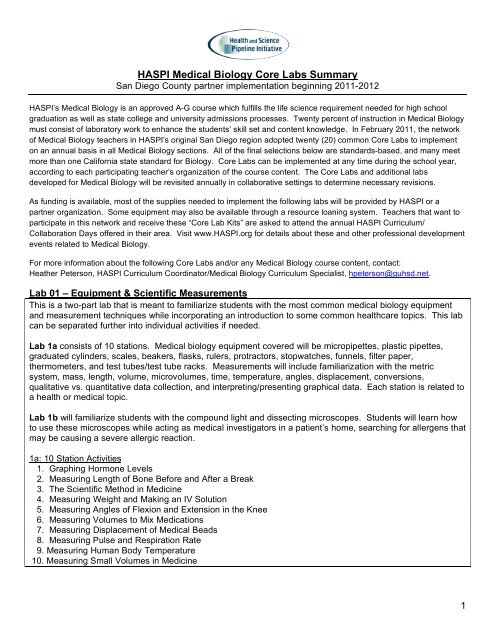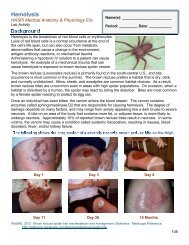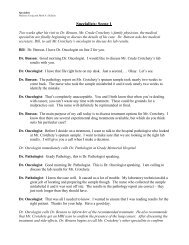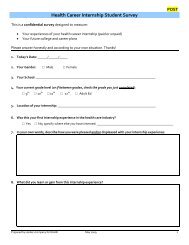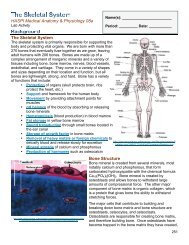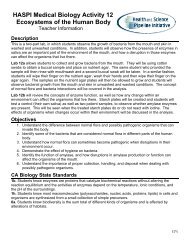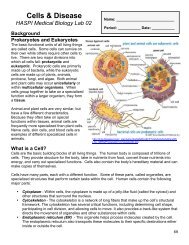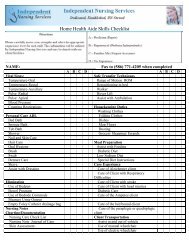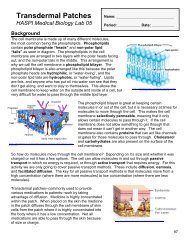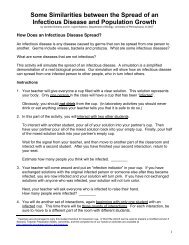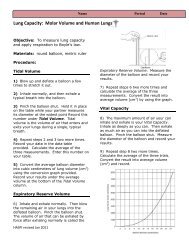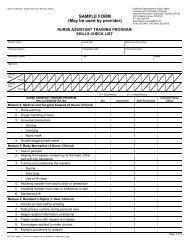00d HASPI Medical Biology Lab Summary.pdf
00d HASPI Medical Biology Lab Summary.pdf
00d HASPI Medical Biology Lab Summary.pdf
You also want an ePaper? Increase the reach of your titles
YUMPU automatically turns print PDFs into web optimized ePapers that Google loves.
<strong>HASPI</strong> <strong>Medical</strong> <strong>Biology</strong> Core <strong>Lab</strong>s <strong>Summary</strong>San Diego County partner implementation beginning 2011-2012<strong>HASPI</strong>’s <strong>Medical</strong> <strong>Biology</strong> is an approved A-G course which fulfills the life science requirement needed for high schoolgraduation as well as state college and university admissions processes. Twenty percent of instruction in <strong>Medical</strong> <strong>Biology</strong>must consist of laboratory work to enhance the students’ skill set and content knowledge. In February 2011, the networkof <strong>Medical</strong> <strong>Biology</strong> teachers in <strong>HASPI</strong>’s original San Diego region adopted twenty (20) common Core <strong>Lab</strong>s to implementon an annual basis in all <strong>Medical</strong> <strong>Biology</strong> sections. All of the final selections below are standards-based, and many meetmore than one California state standard for <strong>Biology</strong>. Core <strong>Lab</strong>s can be implemented at any time during the school year,according to each participating teacher’s organization of the course content. The Core <strong>Lab</strong>s and additional labsdeveloped for <strong>Medical</strong> <strong>Biology</strong> will be revisited annually in collaborative settings to determine necessary revisions.As funding is available, most of the supplies needed to implement the following labs will be provided by <strong>HASPI</strong> or apartner organization. Some equipment may also be available through a resource loaning system. Teachers that want toparticipate in this network and receive these “Core <strong>Lab</strong> Kits” are asked to attend the annual <strong>HASPI</strong> Curriculum/Collaboration Days offered in their area. Visit www.<strong>HASPI</strong>.org for details about these and other professional developmentevents related to <strong>Medical</strong> <strong>Biology</strong>.For more information about the following Core <strong>Lab</strong>s and/or any <strong>Medical</strong> <strong>Biology</strong> course content, contact:Heather Peterson, <strong>HASPI</strong> Curriculum Coordinator/<strong>Medical</strong> <strong>Biology</strong> Curriculum Specialist, hpeterson@guhsd.net.<strong>Lab</strong> 01 – Equipment & Scientific MeasurementsThis is a two-part lab that is meant to familiarize students with the most common medical biology equipmentand measurement techniques while incorporating an introduction to some common healthcare topics. This labcan be separated further into individual activities if needed.<strong>Lab</strong> 1a consists of 10 stations. <strong>Medical</strong> biology equipment covered will be micropipettes, plastic pipettes,graduated cylinders, scales, beakers, flasks, rulers, protractors, stopwatches, funnels, filter paper,thermometers, and test tubes/test tube racks. Measurements will include familiarization with the metricsystem, mass, length, volume, microvolumes, time, temperature, angles, displacement, conversions,qualitative vs. quantitative data collection, and interpreting/presenting graphical data. Each station is related toa health or medical topic.<strong>Lab</strong> 1b will familiarize students with the compound light and dissecting microscopes. Students will learn howto use these microscopes while acting as medical investigators in a patient’s home, searching for allergens thatmay be causing a severe allergic reaction.1a: 10 Station Activities1. Graphing Hormone Levels2. Measuring Length of Bone Before and After a Break3. The Scientific Method in Medicine4. Measuring Weight and Making an IV Solution5. Measuring Angles of Flexion and Extension in the Knee6. Measuring Volumes to Mix Medications7. Measuring Displacement of <strong>Medical</strong> Beads8. Measuring Pulse and Respiration Rate9. Measuring Human Body Temperature10. Measuring Small Volumes in Medicine1
<strong>Lab</strong> 02 – CellsStudents will familiarize themselves further with the compound and dissecting microscopes by comparing andcontrasting prokaryotic cells and eukaryotic cells. Students will also have the opportunity to view bacteria fromyogurt cultures, plant cells from an onion, and animal cells from the student’s own cheek. Disorders that mayoccur at the cellular level will be discussed. A mixture of living protists, bacteria, and algae provides an ampleopportunity for students to view various prokaryotic and eukaryotic cell types.The analysis of the pond mix is done in the context of looking at water from a local stream that a patient drankbefore becoming very ill. The students will be trying to determine if one of the organisms in the water is whathas caused the illness. In addition, an overview of diseases that can be caused by protists or algae will beexplored in the analysis.<strong>Lab</strong> 03 – Cellular Respiration & ExerciseStudents will have the opportunity to observe the effects of exercise on cellular respiration rates. Increasedexercise means increased cellular respiration, which produces more carbon dioxide as a by-product that will bereleased by the lungs. A comparison between carbon dioxide production while resting, during anaerobicexercise, and during aerobic exercise will be made. A review of the cellular respiration process and shortterm/long-termhealth effects of consistent exercise will be available in the analysis.<strong>Lab</strong> 04 – Cell Transport & DialysisStudents will create a simulated dialysis setup to observe how some molecules move through the semipermeablemembrane, and others do not. The simulated set-up will demonstrate how salt, glucose, and urinefreely diffuse through the dialysis machine and/or kidney, while red blood cells and proteins should not. Kidneyfunction in relation to a filtering mechanism will be reviewed, as well as what happens when the kidneys arenot functioning properly.<strong>Lab</strong> 05 – Transdermal PatchesStudents create a simulated skin/cell membrane using dialysis tubing. They then coat filter paper withsimulated medicine and place it on the simulated skin/cell membrane. Students will observe the “medicine”diffuse through the skin/cell membrane into the body/cytosol. Questions and review are meant to support theunderstanding of semi-permeable membranes and the application of osmosis/diffusion within the human bodyin medicine.<strong>Lab</strong> 06 – DNA ExtractionThis lab will allow students to obtain a better understanding of which organisms contain DNA, DNA structure,and the general function of DNA. Part A will have students performing a simple DNA extraction using wheatgerm. They will be working to collect DNA for a pharmacogenetics company called <strong>HASPI</strong> Genetic Horizons,Inc. A review of the field of pharmacogenetics will be given. Students will receive a review on DNA structure,genes, and how they code for specific proteins.Part B is an extension of Part A, and may require additional supplies. Students will be able to create their ownDNA extraction experiment by changing a single variable as they attempt to produce more DNA than they didin Part A. Variables may be a different source for DNA, amounts of solutions, or temperature of solutions.<strong>Lab</strong> 07 – Blood Types & TransfusionsThis is the classic blood typing lab, with a twist. Students are part of a surgical technology team at HopeHospital. The number of patients that have died during surgery is extremely low, but the surgical team lost50% of their surgery patients that required blood transfusions on the previous day. The hospital administrationhas asked for a review of surgical procedures to determine what may have gone wrong. The transfusions arethe commonality between all of the patients, so blood samples from each of the patients as well as bloodsamples from each of the transfusion bags used has been collected. Students are given the task of testingeach blood sample to determine if the bags were possibly mislabeled, resulting in the accidental death of threepatients. In addition, a review of blood type genetics, and additional human allele interactions will be included.Health and Science Pipeline Initiative (<strong>HASPI</strong>) <strong>Medical</strong> <strong>Biology</strong> Core <strong>Lab</strong>s <strong>Summary</strong> 2011 2
<strong>Lab</strong> 08 – KaryotypingStudents will role-play as part of the genetic counseling team for <strong>HASPI</strong> Genetic Horizons, Inc. Expectingparents have chosen to have their unborn child tested for genetic abnormalities and students will beresponsible for determining if any chromosome abnormalities are present. They will cut out and use theattached patient chromosomes to create a human karyotype and determine whether their patient has achromosomal mutation. If their patient does have a chromosomal abnormality they will be responsible foridentifying the disorder that will result and informing the parents of what that may mean for their unborn child.<strong>Lab</strong> 09 – Genetic DisordersStudents will perform research on a chosen or assigned genetic disease, and present that research. Thepresentation can be in the form of an oral presentation, poster, brochure, newsletter, PowerPoint presentation,or written report as decided by the teacher. This project can be done in partners/groups or individually.Students will identify symptoms of the disease, chromosomal abnormality causing the disease, inheritancepattern, diagnosis, organizations, therapies, history, and current research.<strong>Lab</strong> 10 – ElectrophoresisThis is a two-part activity and lab that will familiarize students with the process and applications ofelectrophoresis.Activity 10a is a dry lab that can be used to familiarize students with the electrophoresis process, either inplace of <strong>Lab</strong> 10b if electrophoresis equipment is not available, or as a preview to allow students to have abetter understanding of electrophoresis before they do <strong>Lab</strong> 10b. This paper lab will have students simulate theperformance of an electrophoresis analysis for a family that is trying to determine if the women in their familyhave inherited the mutated BRCA1 and/or BRCA2 gene that predisposes them to hereditary breast cancer.<strong>Lab</strong> 10b Version 1 is for sites that will be using the Invitrogen E-gel System. This system can be checked outfrom <strong>HASPI</strong> for supported sites in San Diego. E-mail hpeterson@guhsd.net to check on availability of theequipment. The students will be testing a family for the gene that causes polycystic kidney disease. Thefather has been diagnosed, and the <strong>HASPI</strong> Genetic Horizons <strong>Lab</strong> has been asked to determine whether any ofthe three children have inherited the gene.<strong>Lab</strong> 10b Version 2 is for sites that will not have access to the Invitrogen E-gel System, and will be using theirown electrophoresis equipment. Students will still be testing a family for the gene that causes polycystickidney disease.<strong>Lab</strong> 11 – Bacteria & AntibioticsThere has been a recent influx of complaints that the normally prescribed ampicillin antibiotic for salmonellainfections has been ineffective, and a few individuals have actually died from the infection. A question hasarisen as to whether the local pharmaceutical company is producing an ineffective antibiotic, or whether a newstrain of salmonella that is antibiotic resistant is the problem. Students will act as medical lab technicians whohave been asked to determine whether salmonella samples collected from patients have actually becomeantibiotic resistant. The concept of how antibiotic resistance occurs, as well as current antibiotic resistantstrains will be reviewed in the analysis. The actual organism used for this lab is a harmless strain of antibioticresistant E. coli (MM294).<strong>Lab</strong> 12 – The Ecosystems of the Human BodyThis is a two-part lab in which students observe the growth of bacteria from the mouth and skin in washed andunwashed conditions. In addition, students will observe how the presence of enzymes in saliva are animportant part of the environment of the mouth, and how a disruption in those enzymes can affect theorganisms that live there.<strong>Lab</strong> 12a allows students to collect and grow bacteria from the mouth. They will be using cotton swabs toobtain an oral sample and place on nutrient agar. The same student who provided the sample will then rinsewith mouthwash and a second oral swab will be taken. In a similar fashion, students will wipe their finger onHealth and Science Pipeline Initiative (<strong>HASPI</strong>) <strong>Medical</strong> <strong>Biology</strong> Core <strong>Lab</strong>s <strong>Summary</strong> 2011 3
the nutrient agar, wash their hands and then wipe their finger on the agar again. The samples on the nutrientagar plates will then be allowed to grow and students will observe bacterial growth from the mouth and skin inunwashed and washed conditions. The concept of normal flora and bacteria interactions will be covered in theanalysis.<strong>Lab</strong> 12b will review the concepts of enzyme function, as well as how any change within an environment canaffect the organisms that live there. Starch plates will be created and students will test a control (their ownsaliva) as well as two patient samples, to observe whether amylase enzymes are present. This will be seenwhen the treated starch plates do or do not react with iodine. The effects of organisms when changes occurwithin their environment will be discussed in the analysis.<strong>Lab</strong> 13 – Epidemics & PandemicsThis is a three-part activity and lab to reinforce how infectious diseases can easily be passed from organism toorganism as well as how an epidemic occurs.Activity 13a will have the teacher treat paper with a small amount of Glo Germ powder that is then handed outand passed around among students. At the end of the class period, the UV black light source will be passedaround the class to observe how easily a bacteria or virus can be passed between people.<strong>Lab</strong> 13b allows students to perform simulated basic microbiology tests to identify an outbreak of an infectiousdisease from a patient culture. The simulated outbreak that students will need to identify is Klebsiellapneumoniae, of which an extremely virulent antibiotic resistant strain has emerged.Activity 13c allows students to research and identify recent and/or current epidemics that have emerged.<strong>Lab</strong> 14 – BioaccumulationThis is a two-part lab and activity to reinforce the how bioaccumulation occurs, as well as the effects ofbioaccumulation on an individual organism.Activity 14a demonstrates how environmental toxins move through the food chain. Each student will beassigned a container that represents an organism in an ocean food chain. Students will simulate the foodchain with larger organisms “eating” smaller organisms, with the eating being represented by emptying thesmaller organism’s container into the larger organism’s container. Mercury will be represented as small redbeads present in each organism’s container. Eventually the human who consumes the tuna will receive all ofthe mercury molecules demonstrating how the bioaccumulation of mercury has occurred.<strong>Lab</strong> 14b demonstrates how toxins can build up in cells and/or organs. Dialysis tubing will be used to representan organism that will be exposed to environmental contaminants. This simple lab will demonstrate how somecontaminants remain within an organism even when that organism is removed from the contaminatedenvironment.<strong>Lab</strong> 15 – Protein Chromatography (Optional)This is a two-part lab to introduce students to the concept and uses of chromatography in separating biologicalcomponents.<strong>Lab</strong> 15a has students use basic chromatography techniques to separate inks from three markers. To addmedical application, the lab has been set up as an investigation into finding whether any markers contain atype of ink that is causing the patient to break out in a rash.<strong>Lab</strong> 15b uses thin-layer chromatography techniques to separate out amino acids from two prepared solutionsamples. The amino acids will fluoresce on the chromatography plates under UV light. The lab is set up todetermine whether a patient with phenylketonuria may have accidentally ingested phenylalanine.Health and Science Pipeline Initiative (<strong>HASPI</strong>) <strong>Medical</strong> <strong>Biology</strong> Core <strong>Lab</strong>s <strong>Summary</strong> 2011 4
<strong>Lab</strong> 16 – Effects of Caffeine, Sugar, Nicotine, & AlcoholStudents use Daphnia magna to observe the effects of nicotine, sugar, caffeine, and alcohol on heart rate.Daphnia magna have a transparent outer body wall, which makes it easy to view the internal organs. Studentswill connect the relationship between the effects of these substances on the nervous system, which thencauses changes in the circulatory system. Students will also gain further experience with microscopetechniques.<strong>Lab</strong> 17 – Digestion & Enzyme ActivityThis lab activity demonstrates how enzymes within the digestive system break down carbohydrates, fats, andproteins. <strong>Lab</strong> activities 17a, 17b, and 17c allow students to perform control tests for known macromoleculesand observe the effects of their respective enzymes. <strong>Lab</strong> activity 17d allows the students to bring in a fooditem, or teacher may provide the food items, to determine what macromolecules are present within those fooditems. Enzyme structure and function is reviewed, as well as the structure and function of macromolecules.The location for optimal enzyme activity within the digestive system is also outlined.<strong>Lab</strong> 18 – UrinalysisThe urinalysis is a very common medical procedure capable of diagnosing many different health issues. In thislab students will act as laboratory technicians, and will be performing a urinalysis on simulated urine samplesthat have been submitted to their lab. A short background on symptoms and reasons for urine collection foreach patient is also given. Students are then required to interpret the results of the urinalysis for each patient.<strong>Lab</strong> 19 – Effects of Diabetes & Simulated Diabetes TestingThis lab activity is actually three labs in one. <strong>Lab</strong> 19a is the actual simulated diabetes testing, while 19b and19c are short activities that reinforce standards concepts.<strong>Lab</strong> 19a is a simulated diabetes test. Students work as lab technicians to test the blood and urine of patientsfor levels of glucose that would diagnose diabetes. The students then fill out a patient report withrecommendations and follow-up by retesting the patient’s blood and urine that have been collected a fewweeks later.<strong>Lab</strong> 19b is a demonstration activity using high water-content vegetables and sugar to show how high sugarcontentof blood in a person with diabetes actually pulls water from surrounding body tissues and results indehydration and frequent urination.Activity 19c is a calculation and graphing activity that determines the relationship between blood glucose andinsulin glucose levels. Students will also calculate the speed of kidney filtration, called glomerular filtrationrates (GFR), and then graph the results. In addition, comparisons between the GFR of healthy kidneys anddiabetic kidneys are made.<strong>Lab</strong> 20 – HIV TransmissionStudents will exchange fluids in a simulation of disease transmission. This lab is specifically simulating HIVtransmission, but could be used for any disease transmitted through the sharing of fluids. Each student will begiven a numbered vial and exchange fluids with 5 other students in the class. One vial will contain sodiumhydroxide that is not visible and acts as simulated HIV. This will be followed by a simulated “HIV test” in whichthe students will use a drop of phenolphthalein, and any vials that have had sodium hydroxide transferred tothem will turn pink indicating contamination with HIV. Students follow up by tracing back to determine whotransferred the virus to them and what their treatment options may be. The background information includesan overview of the development, discovery, and treatment options for HIV. Students will also review whateffect HIV can have on the immune system.Health and Science Pipeline Initiative (<strong>HASPI</strong>) <strong>Medical</strong> <strong>Biology</strong> Core <strong>Lab</strong>s <strong>Summary</strong> 2011 5
Health and Science Pipeline Initiative (<strong>HASPI</strong>) <strong>Medical</strong> <strong>Biology</strong> Core <strong>Lab</strong>s <strong>Summary</strong> 2011 6


